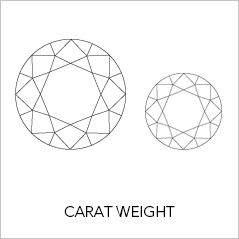When transparent and free from flaws it is highly valued as a precious stone.
It is also used industrially, especially as an abrasive. Crystallized carbon produced artificially is also called diamond.
The name diamond is derived from the ancient Greek adamas("invincible").
Their hardness and high dispersion of light make diamonds useful for industrial applications and jewelry.
Diamonds make excellent abrasives, because they can be scratched only by other diamonds, or man-made materials, which also means that they hold a polish extremely well and retain their lustre.
They have been treasured as gemstones since their use as religious icons in ancient India. Their usage in engraving tools also dates to early human history.
The popularity of diamonds has risen since the 19th century because of increased supply, improved cutting and polishing techniques, growth in the world economy, and innovative and successful marketing campaigns.
Gem diamonds are commonly judged by the “four Cs”: Carat weight,Clarity, Color, and Cut.
Approximately 130 million carats (26,000 kg) are mined annually, with a total value of nearly USD $9 billion, and about 100,000 kg of synthetic diamonds are manufactured annually.
49% of natural diamonds originate from central and southern Africa, although significant sources of the mineral have been discovered in Canada, India, Russia, Brazil, and Australia. They are mined from kimberlite and lamproite volcanic pipes, which brought to the surface the diamond crystals from deep in the Earth where the high pressure and temperature enables the formation of the crystals. The mining and distribution of natural diamonds are subjects of frequent controversy such as with concerns over the sale of conflict diamonds (aka "blood diamonds") by African paramilitary groups.
Cut
The cut of a diamond refers to its proportions. Of the 4C's, the cut is the aspect most directly influenced by man. The other three are dictated by nature.Quite often the cut of a diamond is confused with its shape. Diamonds are cut into various shapes depending upon the original form of the uncut diamond, which is referred to as “rough.” Whatever the shape, a well-cut diamond is better able to reflect light.

Color
The best color is no color. Diamonds allow light to be reflected and dispersed as a rainbow of color. This light dispersion, or color flash, has no effect on the technical grading of color. The absolute finest colorless stone carries a D rating, descending through each letter of the alphabet to Z, designating a diamond of light yellow, brown, or gray. This body color may be caused by the presence of trace elements, such as nitrogen, within the atomic framework of the carbon crystal. These trace elements are so minute that they are scientifically measured in parts per million (ppm). As the body color becomes more intense, the grade for color descends the scale. These gradations are so minute and precise that discerning a single grade (even by an expert) under less than ideal laboratory conditions is extremely difficult. It is always best to compare diamonds graded by either the Gemological Institute of America (GIA) or the American Gem Society (AGS) for accurate color grading. When directly comparing diamonds for color, most consumers are unable to detect a difference unless they are at least two or three color grades apart. We recommend selecting a diamond with a color grade of K or better.

Clarity
Almost all diamonds contain very tiny natural birthmarks known as inclusions. To determine a diamond's clarity, an expert views it under 10-power magnification. In addition to internal inclusions, surface irregularities are referred to as blemishes. These two categories of imperfections-inclusions (internal) and blemishes (external)-make up clarity. The fewer the imperfections, the rare and more valuable is the diamond. Many inclusions are not discernable to the naked eye and require magnification to become apparent. A laboratory-certified clarity rating of SI2 represents the point at which inclusions are technically not apparent to the average naked eye.

Carat
Most people compare carat weight to size. The larger the diamond the more it weighs. The weight of a diamond is expressed in carats. The word carat originated from the carob tree or Ceratonia Siliqua. The tiny seeds of this tree are well known for their uniformity and consistent weight. Traditionally diamonds and gemstones were weighed against these seeds until the system was standardized, and one carat was fixed at 0.2 grams. One carat is divided into 100 points. A diamond weighing one quarter of a carat can also be described as weighing 25 points or 0.25 carats. Points are generally not used to describe weights over one carat. Here are some examples of different weights for round diamonds and their corresponding sizes. These may not be actual size due to your monitor. The approximate girdle diameter is displayed in millimeters.

FAQ
- What is the carat (Karat) System for gold jewellery?
- What is the difference between red, yello and white gold?
- How do I take care of my jewellery?
Contact Us
- UNIT 78, SDF III,
SEEPZ, SEZ, ANDHERI(E),
MUMBAI 400 096,
INDIA


